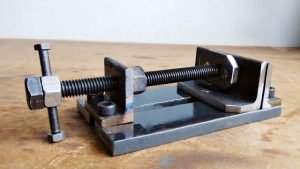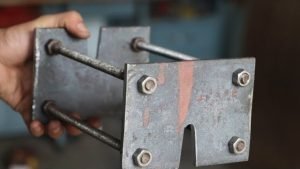
INTRODUCTION :
A drill press vice is primarily used to clamp a workpiece during drilling operations. The vice is designed to hold the workpiece firmly between its jaws so that it stays completely still when the drill bit pierces the surface of the material. The vice is particularly suited to being used with a drill press machine due to its flat base design which has mounting holes which coincide with the mounting holes on the machine’s table. These holes allow bolts to be passed through in order to secure the vice in place on the table. The vice is then mounted to the table of a drill press machine, and holds workpieces securely while the machine is in operation.
A drill press vice is a useful tool as it allows the user to have both hands free and away from the drill while machining. It is a vice that can be used to hold a variety of materials, including metal, plastic and wood. As well as drilling, the tool can be used when completing various other press work jobs, such as reaming, grinding, boring or tapping. A drill press vice can be used for industrial work, as well as by home hobbyists and craftsmen. A drill press vice often has hardened jaws which allows it to withstand the large amount of force that comes with drilling applications. Some models of drill press vice have a three-way base in order to offer alternative mounting options. This design means the vice can be placed in three different positions on the machine’s table, adding to its versatility.
Parts Used :
- Metal base plate 9”*6” (10mm thickness)
- Metal upper plate 3.25”*9” (10mm thickness)
- 3 Nos. solid square bar (1”*1”*3.25”)
- 2 Nos. metal plate 1.25”*3.5” (10mm thickness) for jaws
- 5/8 Main bolt with nut (8” length)
- M8 half threaded bolt with lock nut (5” length)
- Metal piece 1.25”*1.75” (back supporting plate) 10mm thickness
- 4 Nos. M8 countersink allenky bolts (3/4” length)
- 4 Nos. M10 countersink allenky bolts (2” length)
- 6 Nos. ¼ countersink allenky bolts (3/4” length)
- 2 Nos. 3/16 countersink allenky bolts (1/2” length)
How to make :
First step to make a drill vice is cut the metal base plate and upper plate. All the dimensions are shown in the “parts used” section. Then make a slot in both the base plate and upper plate.


Then after, attach the upper plate on base plate by using of 4 Nos. M8 countersink allenky bolts (3/4” length) as shown in the image.

Second step is cut the 3 Nos. solid square bar as the dimension shown in the “parts used” section.

Attach two solid square bar on both end of the metal plate by using of 4 Nos. M10 countersink allenky bolts (2” length).
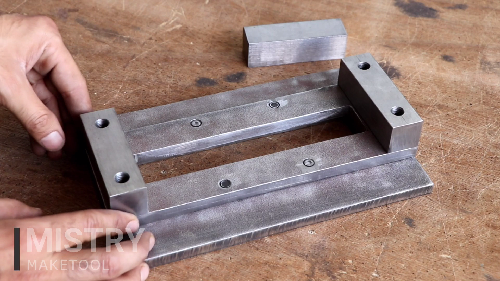
Drill a hole on first solid square bar and make a thread of 5/8 by using of 5/8 tape set as shown in the image.
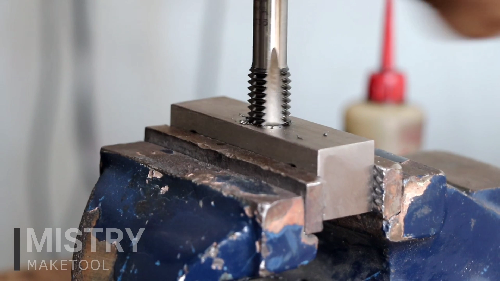
Pass the main bolt through this thread hole.
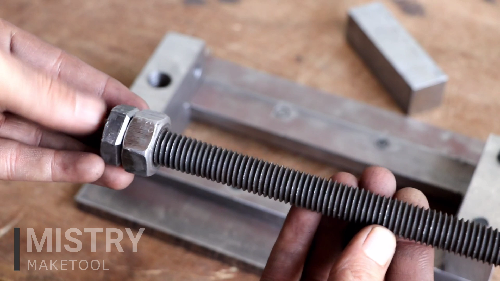
Attach the main bolt (Welded nut on the head of the bolt) with the third solid square bar (called movable jaw) by using of small metal plate and 2 Nos. 3/16 countersink allenky bolts (1/2” length).

Also attach supporting plate (Metal piece 1.25”*1.75” 10mm thickness) on lower side of the base plate by using of the 2 Nos. ¼ countersink allenky bolts (3/4” length), so the movable jaw is easily move on the upper plate without any other unwanted movement.

Attach the 2 Nos. metal plate 1.25”*3.5” (10mm thickness) on movable jaw and one fixed jaw by using of 4 Nos. ¼ countersink allenky bolts (3/4” length) as shown in the image. This metal plate for jaws is useful for properly clamp the workpiece during drilling operations.
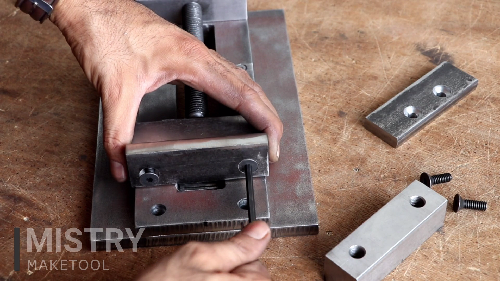
Make slots on base plate for clamping the drill press vice on drill press machine using of bolts.

And at the last attach the handle on drill vice. I have used M8 half threaded bolt with lock nut (5” length) and attach with the head of the main bolt.

Now, the drill press vice is ready to use. It is a vice that can be used to hold a variety of materials, including metal, plastic and wood. This heavy duty drill vice is completing various other press work jobs, such as reaming, grinding, boring or tapping etc.




